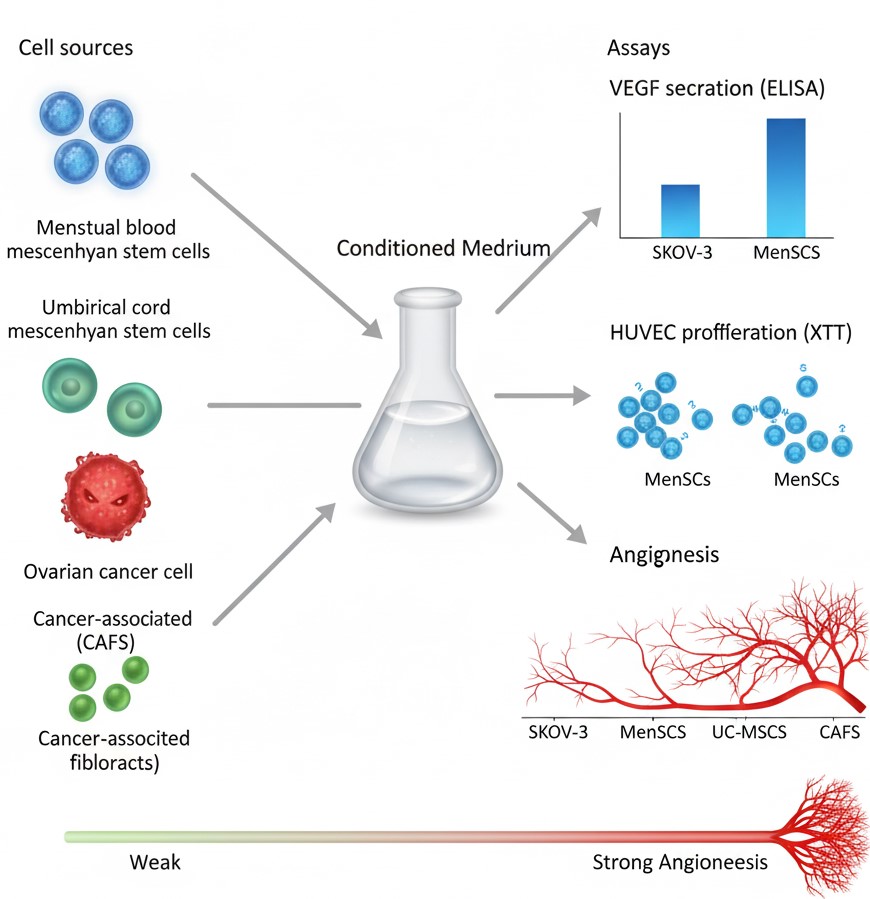Volume 35, Issue 250 (11-2025)
J Mazandaran Univ Med Sci 2025, 35(250): 24-38 |
Back to browse issues page
Download citation:
BibTeX | RIS | EndNote | Medlars | ProCite | Reference Manager | RefWorks
Send citation to:



BibTeX | RIS | EndNote | Medlars | ProCite | Reference Manager | RefWorks
Send citation to:
Zamaniyan M, kalantari S T, Hassannia H, Nassiri Mansour R, Naderi M, Amini Mahabadi J, et al . Evaluation of the Angiogenic Potential of Conditioned Media from Menstrual and Umbilical Cord-Derived Mesenchymal Stem Cells Compared with Tumor Cell- and Ovarian Cancer-Associated Fibroblast-Derived Conditioned Media. J Mazandaran Univ Med Sci 2025; 35 (250) :24-38
URL: http://jmums.mazums.ac.ir/article-1-21780-en.html
URL: http://jmums.mazums.ac.ir/article-1-21780-en.html
Marzieh Zamaniyan 
 , Seyedeh Taravat Kalantari
, Seyedeh Taravat Kalantari 
 , Hadi Hassannia
, Hadi Hassannia 
 , Reyhaneh Nassiri Mansour
, Reyhaneh Nassiri Mansour 
 , Mobin Naderi
, Mobin Naderi 
 , Javad Amini Mahabadi
, Javad Amini Mahabadi 
 , Saeid Abediankenari
, Saeid Abediankenari 
 , Sepideh Peivandi
, Sepideh Peivandi 
 , Seyed Ehsan Enderami
, Seyed Ehsan Enderami 


 , Seyedeh Taravat Kalantari
, Seyedeh Taravat Kalantari 
 , Hadi Hassannia
, Hadi Hassannia 
 , Reyhaneh Nassiri Mansour
, Reyhaneh Nassiri Mansour 
 , Mobin Naderi
, Mobin Naderi 
 , Javad Amini Mahabadi
, Javad Amini Mahabadi 
 , Saeid Abediankenari
, Saeid Abediankenari 
 , Sepideh Peivandi
, Sepideh Peivandi 
 , Seyed Ehsan Enderami
, Seyed Ehsan Enderami 

Abstract: (473 Views)
Background and purpose: Regenerative medicine focuses on replacing dysfunctional cells with mesenchymal stem cells (MSCs) to repair damaged tissues. However, genomic instability and the potential risk of tumor formation remain significant challenges in the use of these cells. Cell-free therapies, such as those based on conditioned media (CM), have emerged as promising alternatives due to their role in promoting angiogenesis. Since malignant solid tumors exhibit the most robust angiogenic activity, this study aimed to compare the angiogenic potential of CM derived from menstrual blood-derived MSCs (MenSCs), umbilical cord-derived MSCs (UC-MSCs), ovarian cancer cells (SKOV-3), and cancer-associated fibroblasts (CAFs).
Materials and methods: UC-MSCs were extracted and passaged, and their mesenchymal nature was confirmed by flow cytometry using CD markers. Isolation and culture of MenSCs, UC-MSCs, CAFs, and tumor cell lines were performed, and CM was subsequently prepared from each. The vascular endothelial growth factor (VEGF) concentration in the CMs was measured by ELISA. Human umbilical vein endothelial cells (HUVECs) were treated with the CMs, and the effects on their proliferation were evaluated using the XTT assay. The angiogenic potential of the CMs was compared using the chicken embryo chorioallantoic membrane (CAM) model.
Results: The results showed that the VEGF concentration in the CMs derived from tumor cells and menstrual blood-derived stem cells was higher than in other CMs. Similarly, the proliferation and migration of HUVECs treated with these CMs were greater than those treated with CMs from other cell types. Overall, the findings indicate that different CMs can promote vascular endothelial cell proliferation and enhance angiogenesis.
Conclusion: The angiogenic potential of tumor cell-derived conditioned medium (CM) is considerably higher than that of menstrual blood-derived stem cell CM. These findings suggest that tumor cell-derived CM could serve as a potent and cost-effective alternative in regenerative medicine, particularly for paracrine-based therapeutic strategies.
Materials and methods: UC-MSCs were extracted and passaged, and their mesenchymal nature was confirmed by flow cytometry using CD markers. Isolation and culture of MenSCs, UC-MSCs, CAFs, and tumor cell lines were performed, and CM was subsequently prepared from each. The vascular endothelial growth factor (VEGF) concentration in the CMs was measured by ELISA. Human umbilical vein endothelial cells (HUVECs) were treated with the CMs, and the effects on their proliferation were evaluated using the XTT assay. The angiogenic potential of the CMs was compared using the chicken embryo chorioallantoic membrane (CAM) model.
Results: The results showed that the VEGF concentration in the CMs derived from tumor cells and menstrual blood-derived stem cells was higher than in other CMs. Similarly, the proliferation and migration of HUVECs treated with these CMs were greater than those treated with CMs from other cell types. Overall, the findings indicate that different CMs can promote vascular endothelial cell proliferation and enhance angiogenesis.
Conclusion: The angiogenic potential of tumor cell-derived conditioned medium (CM) is considerably higher than that of menstrual blood-derived stem cell CM. These findings suggest that tumor cell-derived CM could serve as a potent and cost-effective alternative in regenerative medicine, particularly for paracrine-based therapeutic strategies.
Keywords: strual blood-derived mesenchymal stem cells, umbilical cord-derived mesenchymal stem cells, conditioned medium, cancer-associated fibroblasts
Type of Study: Research(Original) |
Subject:
Biotechnology
Send email to the article author
| Rights and permissions | |
 |
This work is licensed under a Creative Commons Attribution-NonCommercial 4.0 International License. |





